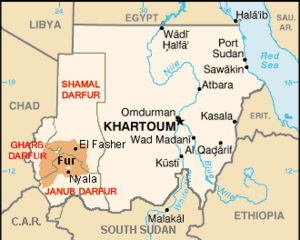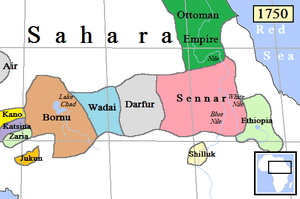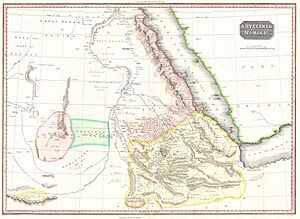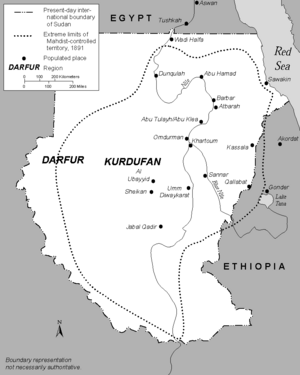History of Darfur facts for kids
Darfur, a large region in Sudan, has a long and interesting history. Many different cultures and kingdoms have called Darfur home. Some of the earliest known kingdoms were the Daju and Tunjur kingdoms.
The recorded history of Darfur really starts in the 1600s. This is when the Fur Sultanate was founded by the Keira dynasty. In 1875, the British and Egyptians took control of Sudan. They ended the Fur dynasty.
The British allowed Darfur some freedom until 1916. Then, they fully took it over. However, Darfur remained undeveloped during and after colonial rule. Most of Sudan's money and resources went to areas along the Nile River. This unfair treatment and lack of development made people in Darfur restless.
Over time, problems like economic hardship and damage to the environment grew. This led to small armed fights starting in the mid-1980s. The violence continued and grew into a major armed movement around 2003.
Contents
Ancient Kingdoms of Darfur
Darfur is mostly dry plains, so it cannot support many people. The main exception is the area around the Jebal Marra mountains. Many groups started in these mountains and then grew to control the whole region.
The early history of Darfur is not well-known. There are not many old records or archaeological findings. This is partly because of ongoing conflicts. One of the first writers to give details about the region was Muhammad al-Idrisi in 1154. He described the Tajuwa people. They were pagans living near the Nile Valley kingdoms. They had two towns and many nomadic people with cattle and camels.
The Tora People
Old stories tell of a group called the Tora. They were said to be white giants who came from the north. They might have been Berbers. The Tora are believed to have brought large stone buildings and advanced farming methods to Darfur. By the 1100s, the Daju people had taken over from the Tora.
The Daju Kingdom
The Daju people lived in Jebel Marra. They seem to have been the main group in Darfur in the earliest recorded times. We don't know exactly how long they ruled. We only have a list of their kings.
Some historians believe the Daju were originally from the Meroites. They moved their capital to Jebel Marra around 1100 AD. This was after attacks from Nubia. The country was called Dardaju, meaning "land of the Daju." Stories say the last Daju sultan was overthrown. The Daju dynasty then moved west around the 1400s. After them, the Tunjur people took power. The country was then called Dartunjur.
The Tunjur Rulers
The Tunjur came to Darfur through Bornu and Wadai. Their first king was said to be Ahmed el-Makur. He married the daughter of the last Daju ruler. Ahmed made many local chiefs obey him, and the country thrived under his rule.
His great-grandson, Sultan Dali, is a famous figure in Darfur's history. He was part Fur on his mother's side. This helped connect the ruling family more closely to the people. Dali divided the country into provinces. He also created a set of laws called the Kitab Dali, or Dali's Book. These laws were different from traditional Islamic law in some ways.
The Darfur Sultanate
Sulayman Solong ruled from 1603 to 1637. He was a great warrior and a devoted Muslim. He is seen as the founder of the Keira dynasty and the Sultanate of Darfur. Sulayman's grandson, Ahmad Bakr (around 1682–1722), made Islam the official religion. He also made the country more prosperous by encouraging people from other regions to move there. His rule reached far to the east.
Throughout its history, the sultanate fought wars with neighboring kingdoms and Arab tribes. Eventually, they fought the Egyptians.
In 1856, a businessman from Khartoum named Al-Zubayr Rahma Mansur started trading in the land south of Darfur. He built a large trading network with armed forces. This area, called Bahr el Ghazal, was a source of valuable goods for Darfur. Darfur used to trade these goods with Egypt and North Africa. Al-Zubayr redirected this trade to Khartoum.
Sultan Ibrahim challenged al-Zubayr. Al-Zubayr then teamed up with the Egyptians. This led to a war that destroyed the sultanate. Ibrahim was killed in battle in 1874. His uncle, Hassab Alla, tried to keep the country independent but was captured in 1875. He was taken to Cairo with his family.
Egyptian and British Control
The people of Darfur were unhappy under Egyptian rule. Egypt itself was under British control after 1882. Many revolts were put down. In 1879, the British Governor-General of Sudan, Charles George Gordon, suggested bringing back the old royal family. This did not happen. In 1881, Rudolf Carl von Slatin became governor of Darfur.
Slatin defended Darfur against the forces of Muhammad Ahmad, who claimed to be the Mahdi. But Slatin surrendered in 1883. Darfur then became part of the Mahdist State. However, the people of Darfur did not support the Mahdi's rule. They fought almost constantly, which led to the Mahdi's forces slowly leaving Darfur.
The Mahdi's successor, Abdallahi ibn Muhammad, was from a small Darfuri tribe. Abdallahi forced warriors from western tribes to move to the capital, Omdurman, and fight for him. This caused rebellions by other nomadic groups.
After Abdallahi was defeated in 1898, the government of Anglo-Egyptian Sudan recognized Ali Dinar as the Sultan of Darfur in 1899. Ali Dinar was a grandson of an earlier sultan. In return, he had to pay an annual tribute. Under Ali Dinar, Darfur had a time of peace and was almost independent again.
British Rule and Neglect
Darfur remained mostly independent until World War I. At that time, Sultan Ali Dinar supported the Ottoman Empire. Because of this, the British invaded Darfur. They made it part of Anglo-Egyptian Sudan in 1916.
During British rule, most resources went to Khartoum and the Blue Nile area. This left the rest of the country, including Darfur, undeveloped. People living near the Nile called themselves "children of the country." They saw people from the west, like Darfuris, as "children of the west." This showed how unevenly the country was treated.
For example, 56% of all money invested went to Khartoum and two other northern provinces. Only about 5-6% went to Darfur. This was despite the fact that the western provinces had more people. Darfur remained undeveloped even after Sudan became independent in 1956.
Sudan's Independence and Growing Tensions
After Sudan gained independence, Darfur became a strong base for the Umma Party. This party was led by Sadiq al-Mahdi. But by the 1960s, some Darfuris started to feel ignored by the Umma Party, even though they supported it.
People became unhappy with the religious parties. This led to the rise of local parties, like the Darfur Development Front (DDF). When a new Islamic constitution was proposed, Muslims from Darfur and other regions joined southerners in opposing it. They saw it as a way for the central government to keep control over their marginalized regions.
The Umma Party split, and politicians started trying to divide "Africans" from "Arabs" in the 1968 elections. This was hard because many people were mixed and looked similar. Sadiq al-Mahdi blamed "the Arabs" for Darfur's neglect. His opponent, his uncle Imam Al-Hadi al-Mahdi, tried to win over Arab groups by talking about "Arabism."
Underdevelopment and political problems at home were made worse by issues with neighboring Chad. In 1969, Sadiq al-Mahdi allowed a rebel group from Chad to set up bases in Darfur. This caused fighting within Darfur. Later, President of Sudan Gaafar Nimeiry expelled the group.
The leader of Libya, Muammar Gaddafi, also became involved in the Chadian conflict. He wanted to create a group of Muslim Arab nations in the Sahel region. Gaddafi supported Arab groups in Darfur. He claimed the province was "Arab." The Khartoum government, instead of calming these new ethnic tensions, sometimes made them worse. This happened when it seemed helpful in the struggles between Sudan, Libya, and Chad.
Civil Wars and Land Shortages
Land and Famine Issues
In 1979, President Nimeiry appointed a governor to Darfur who was not from the region. This sparked riots across Sudan. Nimeiry changed his mind because he feared it would hurt his anti-Libyan efforts.
A big reason for the conflict getting worse was the shrinking amount of farmable land. Over time, less rain fell, and the population grew. This led to more farming on the edge of the Sahara desert. This increased desertification, which meant even less farmable land.
A severe drought from the mid-1970s to the early 1980s caused many people from northern Darfur and Chad to move south. They went to the central farming areas. In 1983 and 1984, the rains failed completely. The Sudanese government ignored warnings about crop failure. They feared it would damage their image abroad. The governor of Darfur resigned in protest.
Darfur then faced a terrible famine. Many Darfuris walked to Khartoum looking for food. The government called them Chadian refugees and sent them away. But there was no food where they were sent, so they walked back. The famine killed an estimated 95,000 Darfuris. It was clear these deaths could have been prevented.
The Second Sudanese Civil War (1983)
Unhappiness with President Nimeiry grew for years. He was overthrown on April 5, 1985. Sadiq al-Mahdi returned from exile. He made a deal with Gaddafi, promising Darfur to Libya if he got money to win elections.
Nimeiry had been strongly supported by the United States. The new military government quickly changed pro-American policies. In August 1985, Libya began sending military supplies and aid to Sudan. They set up a base in Al-Fashir and armed local Arab tribes. By 1986, Libya was helping Sudan fight rebels in southern Sudan.
The famine had greatly changed Darfuri society. Farmers used all available land, blocking traditional routes for herders. Herders, whose animals were starving, tried to force their way south. They attacked farmers who blocked them. Many small weapons were available in Darfur from other conflicts.
Stories spread about herders raiding villages and farmers arming themselves. For Darfuris facing starvation, the idea of "African versus Arab" became important. Some farmers believed that Arabs in Khartoum had let the famine happen. They also thought Darfuri Arabs, armed by Libya, were attacking them. Similarly, some Arab herders believed Africans were trying to punish them by blocking pastureland.
| Region | Total spending per person |
Total income per person |
Support per person |
Development spending per person |
|---|---|---|---|---|
| North | 100.0 | 100.0 | 100.0 | 100.0 |
| Central | 104.0 | 134.1 | 16.8 | 245.5 |
| Khartoum | 161.5 | 213.7 | 13.3 | 532.9 |
| Central ex. Khartoum |
60.6 | 70.9 | 23.8 | 35.5 |
| East | 73.7 | 98.4 | 1.6 | 79.5 |
| West | 44.1 | 43.9 | 43.3 | 17.0 |
| Darfur | 40.6 | 41.5 | 35.1 | 17.2 |
| Kordofan | 49.9 | 47.6 | 57.5 | 15.5 |
In 1991, a rebel force entered Darfur. They hoped to spread the southern rebellion to the west. But they were attacked by the army and local militias. Many Fur villages that had not resisted were burned in revenge.
In 1994, Darfur was divided into three states: Northern, Southern, and Western Darfur. This was done to prevent the Fur people from being a majority in any one state.
Fighting in West Darfur (1998)
Fighting broke out in West Darfur in 1998. These clashes were small, but over 5,000 Masalit people had to leave their homes. Clashes started again in 1999 when nomadic herders moved south earlier than usual.
The 1999 clashes were more deadly. Hundreds of people were killed, including some Arab tribal chiefs. The government sent in military forces to stop the violence. A meeting in 1999 agreed on payments to victims. Many Masalit thinkers and leaders were arrested.
War in Darfur (2003)
In 2003, Darfur became the site of a major rebellion. Two local rebel groups, the Justice and Equality Movement (JEM) and the Sudanese Liberation Army (SLA), accused the government of treating non-Arabs unfairly. They also said the government ignored the Darfur region.
In response, the government launched air attacks. They also supported ground attacks by an Arab militia called the Janjaweed. The Janjaweed were accused of serious human rights violations. They often burned down entire villages. This forced people to flee to refugee camps, mainly in Darfur and Chad. Many camps in Darfur were surrounded by Janjaweed forces.
By the summer of 2004, between 50,000 and 80,000 people had been killed. At least a million people had been forced from their homes. This caused a huge humanitarian crisis in the region.
In May 2006, the main rebel group, the Sudanese Liberation Movement, agreed to a peace deal with the government. Both sides signed the agreement.
Some groups claim that by May 2007, up to 400,000 Darfuris had died because of this conflict.
On August 31, 2020, a peace agreement was signed between the Sudanese authorities and rebel groups. This was meant to end the fighting. However, major clashes still happened in December 2020 and January 2021.
|







